Analysis of Tesco's Competitive Environment and Operations
VerifiedAdded on 2023/01/11
|12
|4086
|97
Report
AI Summary
This report provides a comprehensive analysis of Tesco, a major British retail company. It begins with an introduction to Tesco's history, products, and services, followed by an examination of its competitive environment using Porter's Five Forces, highlighting the threats and opportunities. The re...

Report
Paraphrase This Document
Need a fresh take? Get an instant paraphrase of this document with our AI Paraphraser

Contents
INTRODUCTION...........................................................................................................................3
MAIN BODY...................................................................................................................................3
Background information.........................................................................................................3
Products of Tesco...................................................................................................................4
Competitive Environment......................................................................................................4
Analysis of inbound and outbound logistics along with operations of TESCO.....................6
Analysis any two support activities in the porter ‘s value chain in the Tesco........................7
Identification key values adding activities:............................................................................8
Summary and Reflection........................................................................................................9
CONCLUSION..............................................................................................................................10
REFERENCES..............................................................................................................................11
INTRODUCTION...........................................................................................................................3
MAIN BODY...................................................................................................................................3
Background information.........................................................................................................3
Products of Tesco...................................................................................................................4
Competitive Environment......................................................................................................4
Analysis of inbound and outbound logistics along with operations of TESCO.....................6
Analysis any two support activities in the porter ‘s value chain in the Tesco........................7
Identification key values adding activities:............................................................................8
Summary and Reflection........................................................................................................9
CONCLUSION..............................................................................................................................10
REFERENCES..............................................................................................................................11
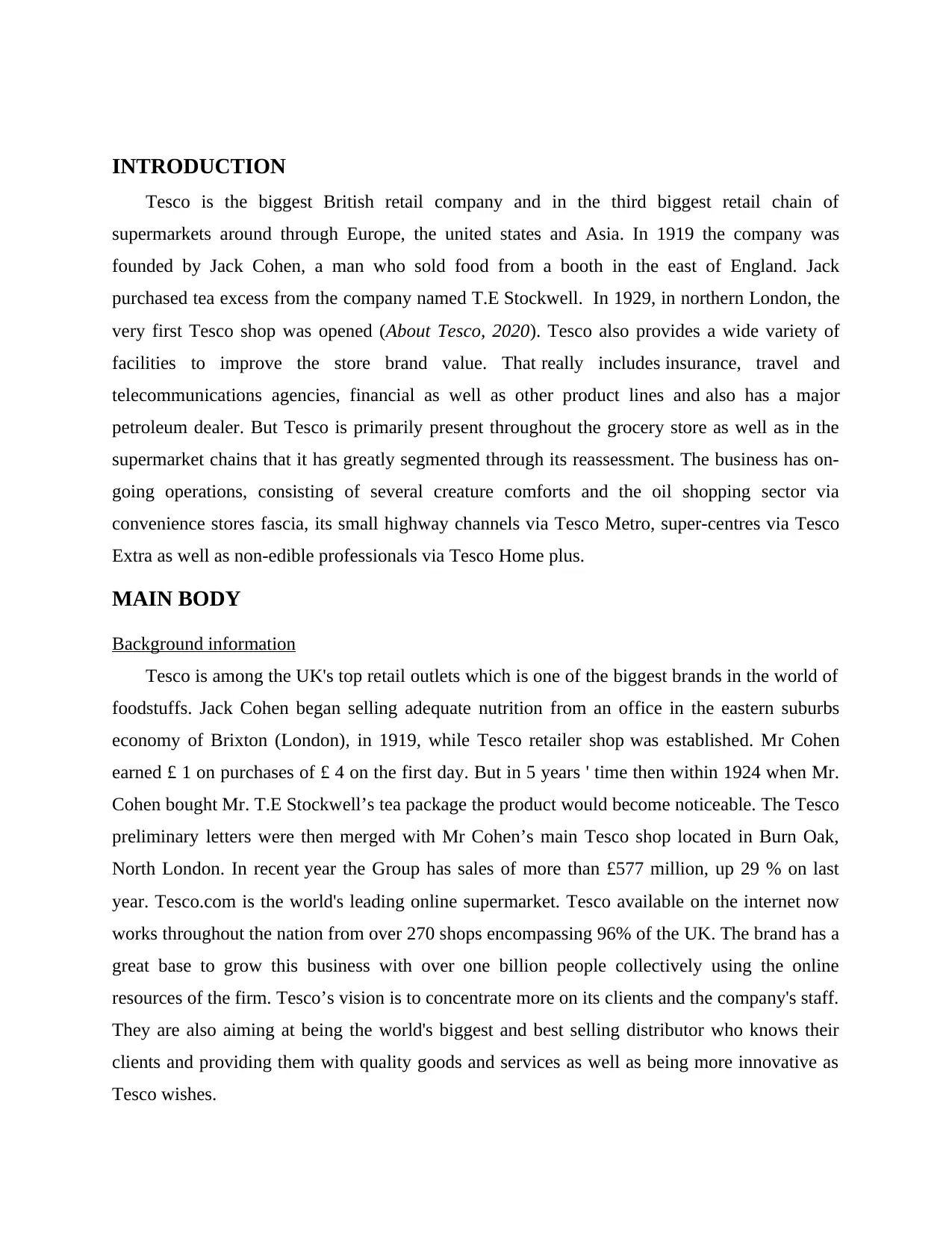
INTRODUCTION
Tesco is the biggest British retail company and in the third biggest retail chain of
supermarkets around through Europe, the united states and Asia. In 1919 the company was
founded by Jack Cohen, a man who sold food from a booth in the east of England. Jack
purchased tea excess from the company named T.E Stockwell. In 1929, in northern London, the
very first Tesco shop was opened (About Tesco, 2020). Tesco also provides a wide variety of
facilities to improve the store brand value. That really includes insurance, travel and
telecommunications agencies, financial as well as other product lines and also has a major
petroleum dealer. But Tesco is primarily present throughout the grocery store as well as in the
supermarket chains that it has greatly segmented through its reassessment. The business has on-
going operations, consisting of several creature comforts and the oil shopping sector via
convenience stores fascia, its small highway channels via Tesco Metro, super-centres via Tesco
Extra as well as non-edible professionals via Tesco Home plus.
MAIN BODY
Background information
Tesco is among the UK's top retail outlets which is one of the biggest brands in the world of
foodstuffs. Jack Cohen began selling adequate nutrition from an office in the eastern suburbs
economy of Brixton (London), in 1919, while Tesco retailer shop was established. Mr Cohen
earned £ 1 on purchases of £ 4 on the first day. But in 5 years ' time then within 1924 when Mr.
Cohen bought Mr. T.E Stockwell’s tea package the product would become noticeable. The Tesco
preliminary letters were then merged with Mr Cohen’s main Tesco shop located in Burn Oak,
North London. In recent year the Group has sales of more than £577 million, up 29 % on last
year. Tesco.com is the world's leading online supermarket. Tesco available on the internet now
works throughout the nation from over 270 shops encompassing 96% of the UK. The brand has a
great base to grow this business with over one billion people collectively using the online
resources of the firm. Tesco’s vision is to concentrate more on its clients and the company's staff.
They are also aiming at being the world's biggest and best selling distributor who knows their
clients and providing them with quality goods and services as well as being more innovative as
Tesco wishes.
Tesco is the biggest British retail company and in the third biggest retail chain of
supermarkets around through Europe, the united states and Asia. In 1919 the company was
founded by Jack Cohen, a man who sold food from a booth in the east of England. Jack
purchased tea excess from the company named T.E Stockwell. In 1929, in northern London, the
very first Tesco shop was opened (About Tesco, 2020). Tesco also provides a wide variety of
facilities to improve the store brand value. That really includes insurance, travel and
telecommunications agencies, financial as well as other product lines and also has a major
petroleum dealer. But Tesco is primarily present throughout the grocery store as well as in the
supermarket chains that it has greatly segmented through its reassessment. The business has on-
going operations, consisting of several creature comforts and the oil shopping sector via
convenience stores fascia, its small highway channels via Tesco Metro, super-centres via Tesco
Extra as well as non-edible professionals via Tesco Home plus.
MAIN BODY
Background information
Tesco is among the UK's top retail outlets which is one of the biggest brands in the world of
foodstuffs. Jack Cohen began selling adequate nutrition from an office in the eastern suburbs
economy of Brixton (London), in 1919, while Tesco retailer shop was established. Mr Cohen
earned £ 1 on purchases of £ 4 on the first day. But in 5 years ' time then within 1924 when Mr.
Cohen bought Mr. T.E Stockwell’s tea package the product would become noticeable. The Tesco
preliminary letters were then merged with Mr Cohen’s main Tesco shop located in Burn Oak,
North London. In recent year the Group has sales of more than £577 million, up 29 % on last
year. Tesco.com is the world's leading online supermarket. Tesco available on the internet now
works throughout the nation from over 270 shops encompassing 96% of the UK. The brand has a
great base to grow this business with over one billion people collectively using the online
resources of the firm. Tesco’s vision is to concentrate more on its clients and the company's staff.
They are also aiming at being the world's biggest and best selling distributor who knows their
clients and providing them with quality goods and services as well as being more innovative as
Tesco wishes.
⊘ This is a preview!⊘
Do you want full access?
Subscribe today to unlock all pages.

Trusted by 1+ million students worldwide
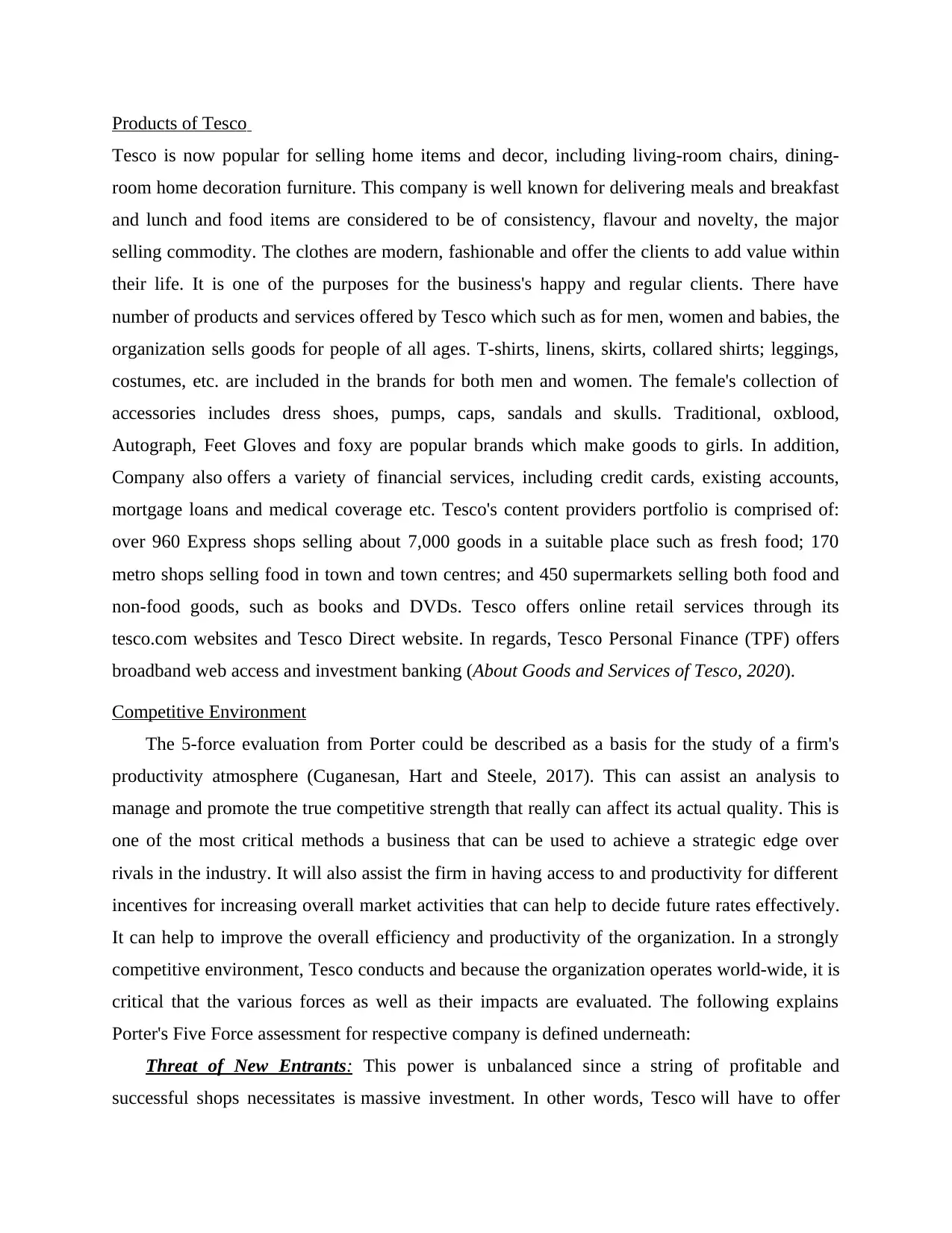
Products of Tesco
Tesco is now popular for selling home items and decor, including living-room chairs, dining-
room home decoration furniture. This company is well known for delivering meals and breakfast
and lunch and food items are considered to be of consistency, flavour and novelty, the major
selling commodity. The clothes are modern, fashionable and offer the clients to add value within
their life. It is one of the purposes for the business's happy and regular clients. There have
number of products and services offered by Tesco which such as for men, women and babies, the
organization sells goods for people of all ages. T-shirts, linens, skirts, collared shirts; leggings,
costumes, etc. are included in the brands for both men and women. The female's collection of
accessories includes dress shoes, pumps, caps, sandals and skulls. Traditional, oxblood,
Autograph, Feet Gloves and foxy are popular brands which make goods to girls. In addition,
Company also offers a variety of financial services, including credit cards, existing accounts,
mortgage loans and medical coverage etc. Tesco's content providers portfolio is comprised of:
over 960 Express shops selling about 7,000 goods in a suitable place such as fresh food; 170
metro shops selling food in town and town centres; and 450 supermarkets selling both food and
non-food goods, such as books and DVDs. Tesco offers online retail services through its
tesco.com websites and Tesco Direct website. In regards, Tesco Personal Finance (TPF) offers
broadband web access and investment banking (About Goods and Services of Tesco, 2020).
Competitive Environment
The 5-force evaluation from Porter could be described as a basis for the study of a firm's
productivity atmosphere (Cuganesan, Hart and Steele, 2017). This can assist an analysis to
manage and promote the true competitive strength that really can affect its actual quality. This is
one of the most critical methods a business that can be used to achieve a strategic edge over
rivals in the industry. It will also assist the firm in having access to and productivity for different
incentives for increasing overall market activities that can help to decide future rates effectively.
It can help to improve the overall efficiency and productivity of the organization. In a strongly
competitive environment, Tesco conducts and because the organization operates world-wide, it is
critical that the various forces as well as their impacts are evaluated. The following explains
Porter's Five Force assessment for respective company is defined underneath:
Threat of New Entrants: This power is unbalanced since a string of profitable and
successful shops necessitates is massive investment. In other words, Tesco will have to offer
Tesco is now popular for selling home items and decor, including living-room chairs, dining-
room home decoration furniture. This company is well known for delivering meals and breakfast
and lunch and food items are considered to be of consistency, flavour and novelty, the major
selling commodity. The clothes are modern, fashionable and offer the clients to add value within
their life. It is one of the purposes for the business's happy and regular clients. There have
number of products and services offered by Tesco which such as for men, women and babies, the
organization sells goods for people of all ages. T-shirts, linens, skirts, collared shirts; leggings,
costumes, etc. are included in the brands for both men and women. The female's collection of
accessories includes dress shoes, pumps, caps, sandals and skulls. Traditional, oxblood,
Autograph, Feet Gloves and foxy are popular brands which make goods to girls. In addition,
Company also offers a variety of financial services, including credit cards, existing accounts,
mortgage loans and medical coverage etc. Tesco's content providers portfolio is comprised of:
over 960 Express shops selling about 7,000 goods in a suitable place such as fresh food; 170
metro shops selling food in town and town centres; and 450 supermarkets selling both food and
non-food goods, such as books and DVDs. Tesco offers online retail services through its
tesco.com websites and Tesco Direct website. In regards, Tesco Personal Finance (TPF) offers
broadband web access and investment banking (About Goods and Services of Tesco, 2020).
Competitive Environment
The 5-force evaluation from Porter could be described as a basis for the study of a firm's
productivity atmosphere (Cuganesan, Hart and Steele, 2017). This can assist an analysis to
manage and promote the true competitive strength that really can affect its actual quality. This is
one of the most critical methods a business that can be used to achieve a strategic edge over
rivals in the industry. It will also assist the firm in having access to and productivity for different
incentives for increasing overall market activities that can help to decide future rates effectively.
It can help to improve the overall efficiency and productivity of the organization. In a strongly
competitive environment, Tesco conducts and because the organization operates world-wide, it is
critical that the various forces as well as their impacts are evaluated. The following explains
Porter's Five Force assessment for respective company is defined underneath:
Threat of New Entrants: This power is unbalanced since a string of profitable and
successful shops necessitates is massive investment. In other words, Tesco will have to offer
Paraphrase This Document
Need a fresh take? Get an instant paraphrase of this document with our AI Paraphraser
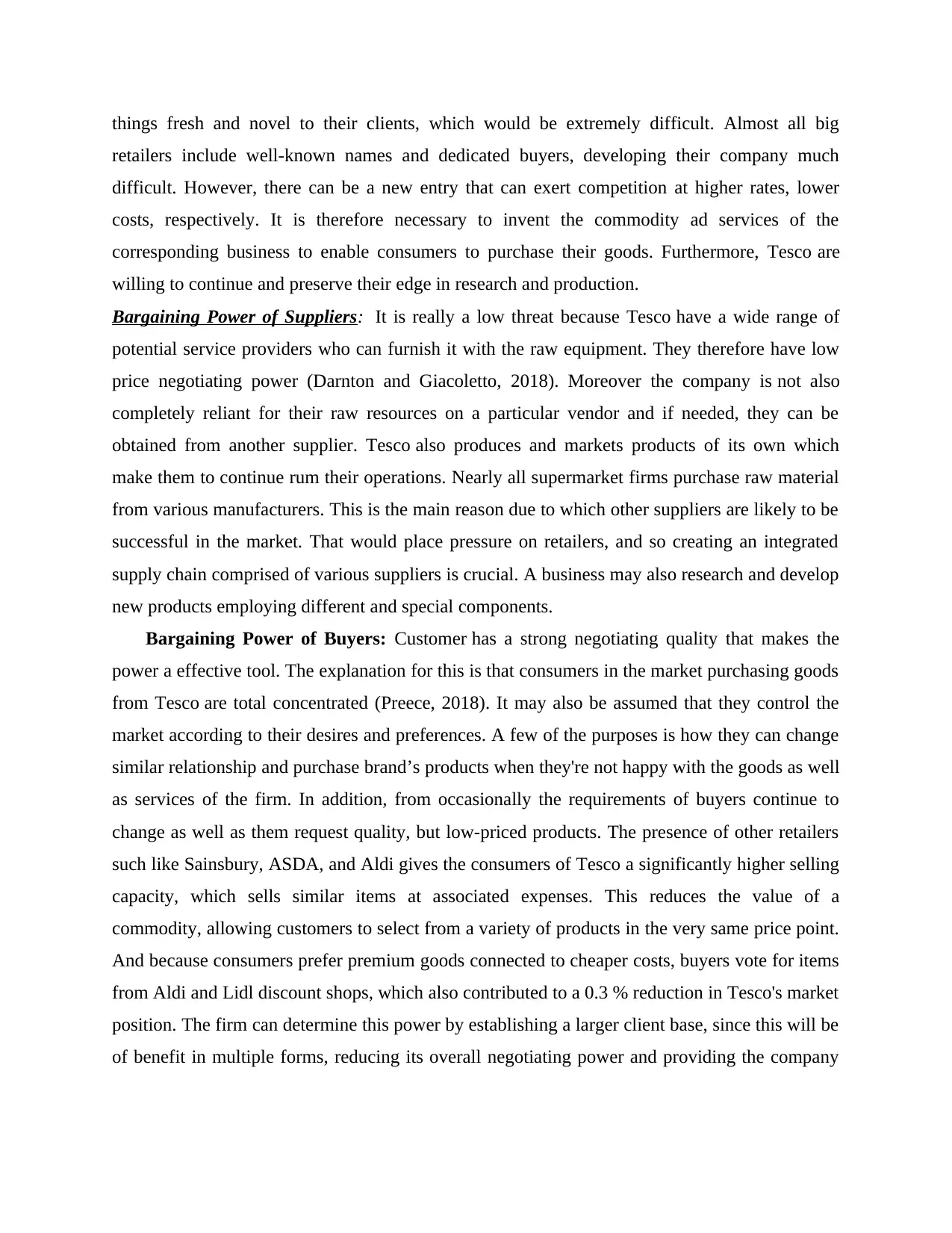
things fresh and novel to their clients, which would be extremely difficult. Almost all big
retailers include well-known names and dedicated buyers, developing their company much
difficult. However, there can be a new entry that can exert competition at higher rates, lower
costs, respectively. It is therefore necessary to invent the commodity ad services of the
corresponding business to enable consumers to purchase their goods. Furthermore, Tesco are
willing to continue and preserve their edge in research and production.
Bargaining Power of Suppliers: It is really a low threat because Tesco have a wide range of
potential service providers who can furnish it with the raw equipment. They therefore have low
price negotiating power (Darnton and Giacoletto, 2018). Moreover the company is not also
completely reliant for their raw resources on a particular vendor and if needed, they can be
obtained from another supplier. Tesco also produces and markets products of its own which
make them to continue rum their operations. Nearly all supermarket firms purchase raw material
from various manufacturers. This is the main reason due to which other suppliers are likely to be
successful in the market. That would place pressure on retailers, and so creating an integrated
supply chain comprised of various suppliers is crucial. A business may also research and develop
new products employing different and special components.
Bargaining Power of Buyers: Customer has a strong negotiating quality that makes the
power a effective tool. The explanation for this is that consumers in the market purchasing goods
from Tesco are total concentrated (Preece, 2018). It may also be assumed that they control the
market according to their desires and preferences. A few of the purposes is how they can change
similar relationship and purchase brand’s products when they're not happy with the goods as well
as services of the firm. In addition, from occasionally the requirements of buyers continue to
change as well as them request quality, but low-priced products. The presence of other retailers
such like Sainsbury, ASDA, and Aldi gives the consumers of Tesco a significantly higher selling
capacity, which sells similar items at associated expenses. This reduces the value of a
commodity, allowing customers to select from a variety of products in the very same price point.
And because consumers prefer premium goods connected to cheaper costs, buyers vote for items
from Aldi and Lidl discount shops, which also contributed to a 0.3 % reduction in Tesco's market
position. The firm can determine this power by establishing a larger client base, since this will be
of benefit in multiple forms, reducing its overall negotiating power and providing the company
retailers include well-known names and dedicated buyers, developing their company much
difficult. However, there can be a new entry that can exert competition at higher rates, lower
costs, respectively. It is therefore necessary to invent the commodity ad services of the
corresponding business to enable consumers to purchase their goods. Furthermore, Tesco are
willing to continue and preserve their edge in research and production.
Bargaining Power of Suppliers: It is really a low threat because Tesco have a wide range of
potential service providers who can furnish it with the raw equipment. They therefore have low
price negotiating power (Darnton and Giacoletto, 2018). Moreover the company is not also
completely reliant for their raw resources on a particular vendor and if needed, they can be
obtained from another supplier. Tesco also produces and markets products of its own which
make them to continue rum their operations. Nearly all supermarket firms purchase raw material
from various manufacturers. This is the main reason due to which other suppliers are likely to be
successful in the market. That would place pressure on retailers, and so creating an integrated
supply chain comprised of various suppliers is crucial. A business may also research and develop
new products employing different and special components.
Bargaining Power of Buyers: Customer has a strong negotiating quality that makes the
power a effective tool. The explanation for this is that consumers in the market purchasing goods
from Tesco are total concentrated (Preece, 2018). It may also be assumed that they control the
market according to their desires and preferences. A few of the purposes is how they can change
similar relationship and purchase brand’s products when they're not happy with the goods as well
as services of the firm. In addition, from occasionally the requirements of buyers continue to
change as well as them request quality, but low-priced products. The presence of other retailers
such like Sainsbury, ASDA, and Aldi gives the consumers of Tesco a significantly higher selling
capacity, which sells similar items at associated expenses. This reduces the value of a
commodity, allowing customers to select from a variety of products in the very same price point.
And because consumers prefer premium goods connected to cheaper costs, buyers vote for items
from Aldi and Lidl discount shops, which also contributed to a 0.3 % reduction in Tesco's market
position. The firm can determine this power by establishing a larger client base, since this will be
of benefit in multiple forms, reducing its overall negotiating power and providing the company
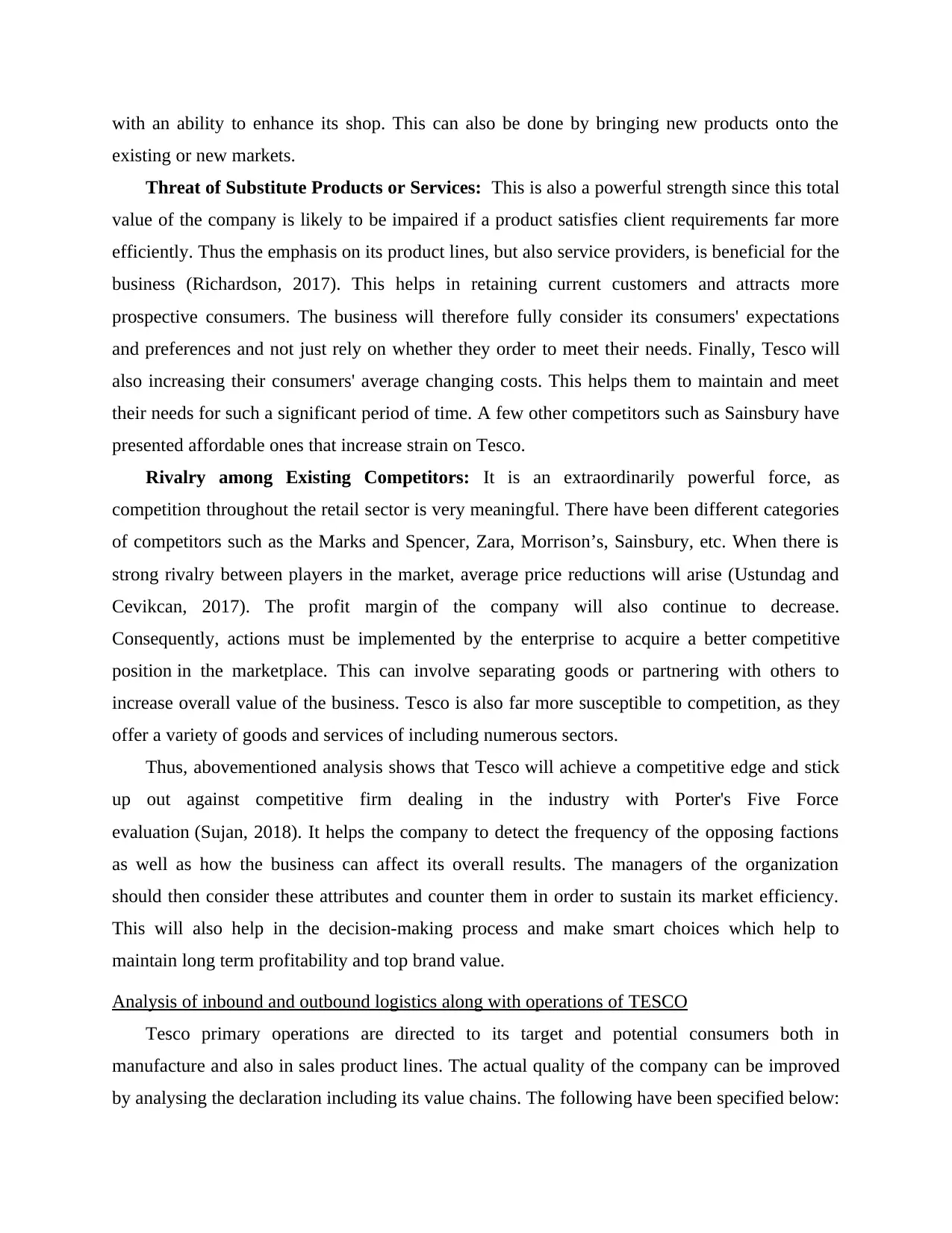
with an ability to enhance its shop. This can also be done by bringing new products onto the
existing or new markets.
Threat of Substitute Products or Services: This is also a powerful strength since this total
value of the company is likely to be impaired if a product satisfies client requirements far more
efficiently. Thus the emphasis on its product lines, but also service providers, is beneficial for the
business (Richardson, 2017). This helps in retaining current customers and attracts more
prospective consumers. The business will therefore fully consider its consumers' expectations
and preferences and not just rely on whether they order to meet their needs. Finally, Tesco will
also increasing their consumers' average changing costs. This helps them to maintain and meet
their needs for such a significant period of time. A few other competitors such as Sainsbury have
presented affordable ones that increase strain on Tesco.
Rivalry among Existing Competitors: It is an extraordinarily powerful force, as
competition throughout the retail sector is very meaningful. There have been different categories
of competitors such as the Marks and Spencer, Zara, Morrison’s, Sainsbury, etc. When there is
strong rivalry between players in the market, average price reductions will arise (Ustundag and
Cevikcan, 2017). The profit margin of the company will also continue to decrease.
Consequently, actions must be implemented by the enterprise to acquire a better competitive
position in the marketplace. This can involve separating goods or partnering with others to
increase overall value of the business. Tesco is also far more susceptible to competition, as they
offer a variety of goods and services of including numerous sectors.
Thus, abovementioned analysis shows that Tesco will achieve a competitive edge and stick
up out against competitive firm dealing in the industry with Porter's Five Force
evaluation (Sujan, 2018). It helps the company to detect the frequency of the opposing factions
as well as how the business can affect its overall results. The managers of the organization
should then consider these attributes and counter them in order to sustain its market efficiency.
This will also help in the decision-making process and make smart choices which help to
maintain long term profitability and top brand value.
Analysis of inbound and outbound logistics along with operations of TESCO
Tesco primary operations are directed to its target and potential consumers both in
manufacture and also in sales product lines. The actual quality of the company can be improved
by analysing the declaration including its value chains. The following have been specified below:
existing or new markets.
Threat of Substitute Products or Services: This is also a powerful strength since this total
value of the company is likely to be impaired if a product satisfies client requirements far more
efficiently. Thus the emphasis on its product lines, but also service providers, is beneficial for the
business (Richardson, 2017). This helps in retaining current customers and attracts more
prospective consumers. The business will therefore fully consider its consumers' expectations
and preferences and not just rely on whether they order to meet their needs. Finally, Tesco will
also increasing their consumers' average changing costs. This helps them to maintain and meet
their needs for such a significant period of time. A few other competitors such as Sainsbury have
presented affordable ones that increase strain on Tesco.
Rivalry among Existing Competitors: It is an extraordinarily powerful force, as
competition throughout the retail sector is very meaningful. There have been different categories
of competitors such as the Marks and Spencer, Zara, Morrison’s, Sainsbury, etc. When there is
strong rivalry between players in the market, average price reductions will arise (Ustundag and
Cevikcan, 2017). The profit margin of the company will also continue to decrease.
Consequently, actions must be implemented by the enterprise to acquire a better competitive
position in the marketplace. This can involve separating goods or partnering with others to
increase overall value of the business. Tesco is also far more susceptible to competition, as they
offer a variety of goods and services of including numerous sectors.
Thus, abovementioned analysis shows that Tesco will achieve a competitive edge and stick
up out against competitive firm dealing in the industry with Porter's Five Force
evaluation (Sujan, 2018). It helps the company to detect the frequency of the opposing factions
as well as how the business can affect its overall results. The managers of the organization
should then consider these attributes and counter them in order to sustain its market efficiency.
This will also help in the decision-making process and make smart choices which help to
maintain long term profitability and top brand value.
Analysis of inbound and outbound logistics along with operations of TESCO
Tesco primary operations are directed to its target and potential consumers both in
manufacture and also in sales product lines. The actual quality of the company can be improved
by analysing the declaration including its value chains. The following have been specified below:
⊘ This is a preview!⊘
Do you want full access?
Subscribe today to unlock all pages.

Trusted by 1+ million students worldwide

Inbound logistics: Close relations between manufacturers are necessary as appropriate
assistance is needed in terms of collection, storage and delivery (Dooley, 2017). If
Tesco inbound logistics does not evaluate this, this will adversely affect its performance and
forehead various issues relating to the development of products. Thus the company must
demonstrate every element of the transformation to finally completed services or goods of
manufactured goods. In this respect, however, functionalities may be compromised if they are
not preserved, such as the collection of raw product again from manufacturers and their storage
as well as the internal delivery to the manufacturing facility.
Operations: If raw commodities are provided by suppliers and obtained by Tesco it
becomes important to analyse the company processes. The company is now ready to perform
processing of raw resources into some kind of perfect or definitely a good, such as machining,
packaging, assembly and evaluating as requested. Furthermore, maintenance of equipment
replacement is also included. That covers both the management and development aspects of
facilities. Manager of Tesco also analyses of the operations are needed to increase profitability,
boost performance and reliability competitive advantage in the marketplace.
Outbound Logistics: This includes activities which are liable for delivering products
through separate brokers to about their final consumers. Almost all of them are manufacturing,
managing of materials, handling of orders, carriage and distribution. Manager of Tesco analyse
and optimize operational efficiency in order to explore strategic advantage in order to achieve
their goals (Purcell and others, 2017). If these operations are performed on a timely basis, costs
and deliveries will be optimised and negative consequences for brand efficiency and durability
will be eliminated. This would add to consumer satisfaction by enhancing market growth
prospects. Consequently, if products are available and fast delivery, it is essential for Tesco to
demonstrate their outbound procedures.
Analysis any two support activities in the porter ‘s value chain in the Tesco
The evaluation of the value chain describes a company's business studies methods and
tools for taking competitive position in the industry by value addition to the interface resources
to produce an efficient services and products output that has effective values. IT supports the
brands and spencer in achieving the desired level of results on the target audience and achieving
the objectives and aims in even the most economical manner (Delgado and Alcacer, 2016). This
same value chain analysis consists of two main activities that allow the respective company
assistance is needed in terms of collection, storage and delivery (Dooley, 2017). If
Tesco inbound logistics does not evaluate this, this will adversely affect its performance and
forehead various issues relating to the development of products. Thus the company must
demonstrate every element of the transformation to finally completed services or goods of
manufactured goods. In this respect, however, functionalities may be compromised if they are
not preserved, such as the collection of raw product again from manufacturers and their storage
as well as the internal delivery to the manufacturing facility.
Operations: If raw commodities are provided by suppliers and obtained by Tesco it
becomes important to analyse the company processes. The company is now ready to perform
processing of raw resources into some kind of perfect or definitely a good, such as machining,
packaging, assembly and evaluating as requested. Furthermore, maintenance of equipment
replacement is also included. That covers both the management and development aspects of
facilities. Manager of Tesco also analyses of the operations are needed to increase profitability,
boost performance and reliability competitive advantage in the marketplace.
Outbound Logistics: This includes activities which are liable for delivering products
through separate brokers to about their final consumers. Almost all of them are manufacturing,
managing of materials, handling of orders, carriage and distribution. Manager of Tesco analyse
and optimize operational efficiency in order to explore strategic advantage in order to achieve
their goals (Purcell and others, 2017). If these operations are performed on a timely basis, costs
and deliveries will be optimised and negative consequences for brand efficiency and durability
will be eliminated. This would add to consumer satisfaction by enhancing market growth
prospects. Consequently, if products are available and fast delivery, it is essential for Tesco to
demonstrate their outbound procedures.
Analysis any two support activities in the porter ‘s value chain in the Tesco
The evaluation of the value chain describes a company's business studies methods and
tools for taking competitive position in the industry by value addition to the interface resources
to produce an efficient services and products output that has effective values. IT supports the
brands and spencer in achieving the desired level of results on the target audience and achieving
the objectives and aims in even the most economical manner (Delgado and Alcacer, 2016). This
same value chain analysis consists of two main activities that allow the respective company
Paraphrase This Document
Need a fresh take? Get an instant paraphrase of this document with our AI Paraphraser
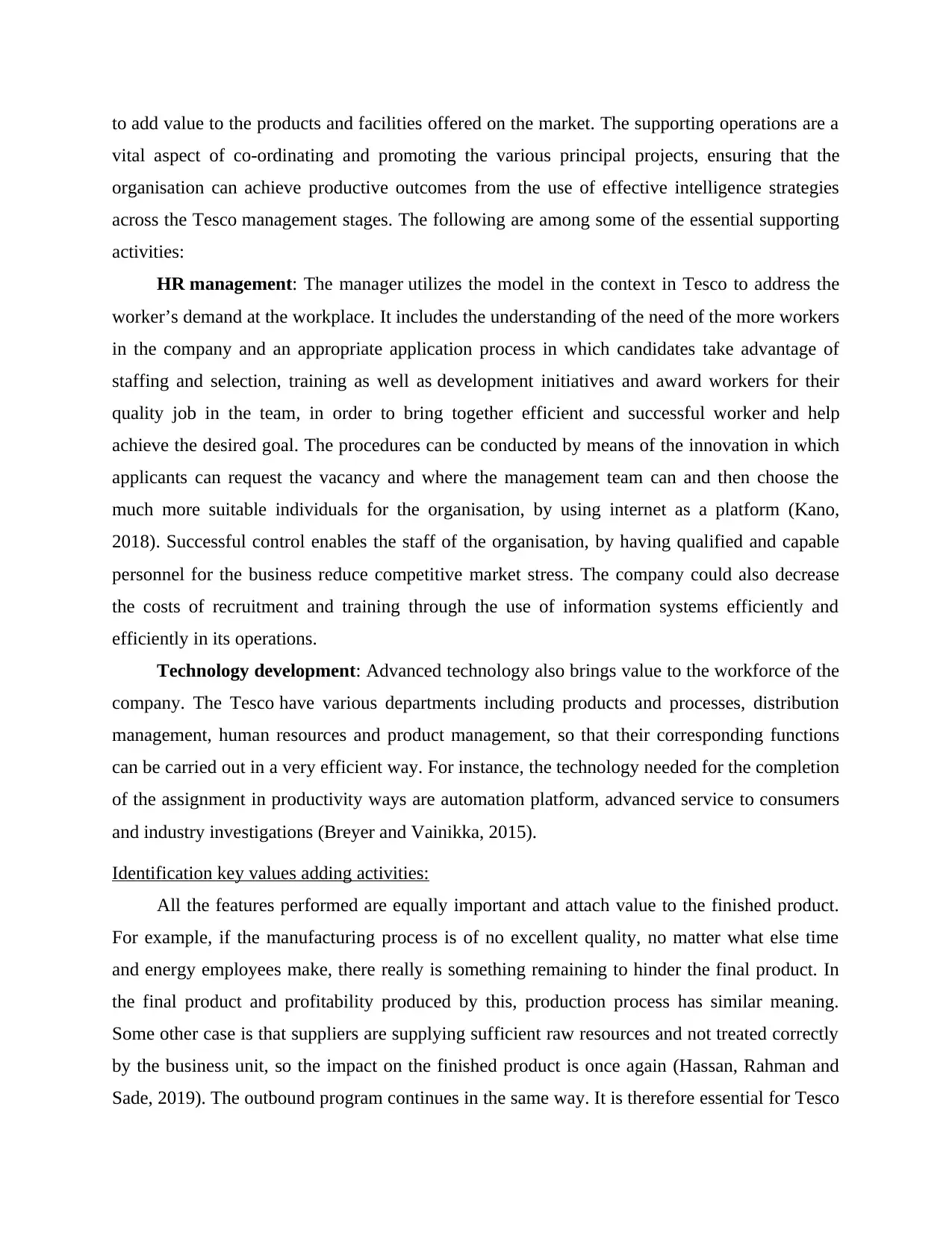
to add value to the products and facilities offered on the market. The supporting operations are a
vital aspect of co-ordinating and promoting the various principal projects, ensuring that the
organisation can achieve productive outcomes from the use of effective intelligence strategies
across the Tesco management stages. The following are among some of the essential supporting
activities:
HR management: The manager utilizes the model in the context in Tesco to address the
worker’s demand at the workplace. It includes the understanding of the need of the more workers
in the company and an appropriate application process in which candidates take advantage of
staffing and selection, training as well as development initiatives and award workers for their
quality job in the team, in order to bring together efficient and successful worker and help
achieve the desired goal. The procedures can be conducted by means of the innovation in which
applicants can request the vacancy and where the management team can and then choose the
much more suitable individuals for the organisation, by using internet as a platform (Kano,
2018). Successful control enables the staff of the organisation, by having qualified and capable
personnel for the business reduce competitive market stress. The company could also decrease
the costs of recruitment and training through the use of information systems efficiently and
efficiently in its operations.
Technology development: Advanced technology also brings value to the workforce of the
company. The Tesco have various departments including products and processes, distribution
management, human resources and product management, so that their corresponding functions
can be carried out in a very efficient way. For instance, the technology needed for the completion
of the assignment in productivity ways are automation platform, advanced service to consumers
and industry investigations (Breyer and Vainikka, 2015).
Identification key values adding activities:
All the features performed are equally important and attach value to the finished product.
For example, if the manufacturing process is of no excellent quality, no matter what else time
and energy employees make, there really is something remaining to hinder the final product. In
the final product and profitability produced by this, production process has similar meaning.
Some other case is that suppliers are supplying sufficient raw resources and not treated correctly
by the business unit, so the impact on the finished product is once again (Hassan, Rahman and
Sade, 2019). The outbound program continues in the same way. It is therefore essential for Tesco
vital aspect of co-ordinating and promoting the various principal projects, ensuring that the
organisation can achieve productive outcomes from the use of effective intelligence strategies
across the Tesco management stages. The following are among some of the essential supporting
activities:
HR management: The manager utilizes the model in the context in Tesco to address the
worker’s demand at the workplace. It includes the understanding of the need of the more workers
in the company and an appropriate application process in which candidates take advantage of
staffing and selection, training as well as development initiatives and award workers for their
quality job in the team, in order to bring together efficient and successful worker and help
achieve the desired goal. The procedures can be conducted by means of the innovation in which
applicants can request the vacancy and where the management team can and then choose the
much more suitable individuals for the organisation, by using internet as a platform (Kano,
2018). Successful control enables the staff of the organisation, by having qualified and capable
personnel for the business reduce competitive market stress. The company could also decrease
the costs of recruitment and training through the use of information systems efficiently and
efficiently in its operations.
Technology development: Advanced technology also brings value to the workforce of the
company. The Tesco have various departments including products and processes, distribution
management, human resources and product management, so that their corresponding functions
can be carried out in a very efficient way. For instance, the technology needed for the completion
of the assignment in productivity ways are automation platform, advanced service to consumers
and industry investigations (Breyer and Vainikka, 2015).
Identification key values adding activities:
All the features performed are equally important and attach value to the finished product.
For example, if the manufacturing process is of no excellent quality, no matter what else time
and energy employees make, there really is something remaining to hinder the final product. In
the final product and profitability produced by this, production process has similar meaning.
Some other case is that suppliers are supplying sufficient raw resources and not treated correctly
by the business unit, so the impact on the finished product is once again (Hassan, Rahman and
Sade, 2019). The outbound program continues in the same way. It is therefore essential for Tesco
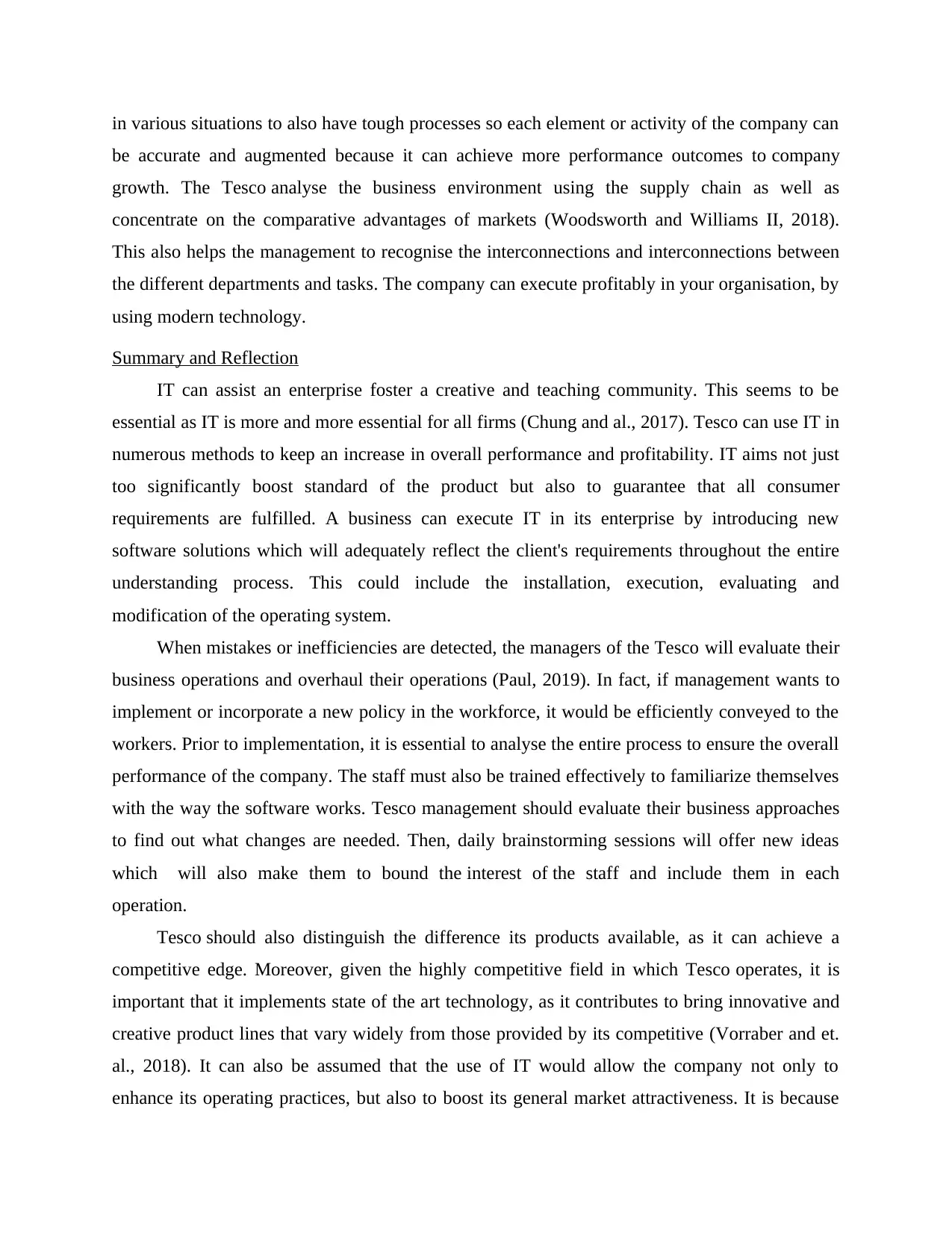
in various situations to also have tough processes so each element or activity of the company can
be accurate and augmented because it can achieve more performance outcomes to company
growth. The Tesco analyse the business environment using the supply chain as well as
concentrate on the comparative advantages of markets (Woodsworth and Williams II, 2018).
This also helps the management to recognise the interconnections and interconnections between
the different departments and tasks. The company can execute profitably in your organisation, by
using modern technology.
Summary and Reflection
IT can assist an enterprise foster a creative and teaching community. This seems to be
essential as IT is more and more essential for all firms (Chung and al., 2017). Tesco can use IT in
numerous methods to keep an increase in overall performance and profitability. IT aims not just
too significantly boost standard of the product but also to guarantee that all consumer
requirements are fulfilled. A business can execute IT in its enterprise by introducing new
software solutions which will adequately reflect the client's requirements throughout the entire
understanding process. This could include the installation, execution, evaluating and
modification of the operating system.
When mistakes or inefficiencies are detected, the managers of the Tesco will evaluate their
business operations and overhaul their operations (Paul, 2019). In fact, if management wants to
implement or incorporate a new policy in the workforce, it would be efficiently conveyed to the
workers. Prior to implementation, it is essential to analyse the entire process to ensure the overall
performance of the company. The staff must also be trained effectively to familiarize themselves
with the way the software works. Tesco management should evaluate their business approaches
to find out what changes are needed. Then, daily brainstorming sessions will offer new ideas
which will also make them to bound the interest of the staff and include them in each
operation.
Tesco should also distinguish the difference its products available, as it can achieve a
competitive edge. Moreover, given the highly competitive field in which Tesco operates, it is
important that it implements state of the art technology, as it contributes to bring innovative and
creative product lines that vary widely from those provided by its competitive (Vorraber and et.
al., 2018). It can also be assumed that the use of IT would allow the company not only to
enhance its operating practices, but also to boost its general market attractiveness. It is because
be accurate and augmented because it can achieve more performance outcomes to company
growth. The Tesco analyse the business environment using the supply chain as well as
concentrate on the comparative advantages of markets (Woodsworth and Williams II, 2018).
This also helps the management to recognise the interconnections and interconnections between
the different departments and tasks. The company can execute profitably in your organisation, by
using modern technology.
Summary and Reflection
IT can assist an enterprise foster a creative and teaching community. This seems to be
essential as IT is more and more essential for all firms (Chung and al., 2017). Tesco can use IT in
numerous methods to keep an increase in overall performance and profitability. IT aims not just
too significantly boost standard of the product but also to guarantee that all consumer
requirements are fulfilled. A business can execute IT in its enterprise by introducing new
software solutions which will adequately reflect the client's requirements throughout the entire
understanding process. This could include the installation, execution, evaluating and
modification of the operating system.
When mistakes or inefficiencies are detected, the managers of the Tesco will evaluate their
business operations and overhaul their operations (Paul, 2019). In fact, if management wants to
implement or incorporate a new policy in the workforce, it would be efficiently conveyed to the
workers. Prior to implementation, it is essential to analyse the entire process to ensure the overall
performance of the company. The staff must also be trained effectively to familiarize themselves
with the way the software works. Tesco management should evaluate their business approaches
to find out what changes are needed. Then, daily brainstorming sessions will offer new ideas
which will also make them to bound the interest of the staff and include them in each
operation.
Tesco should also distinguish the difference its products available, as it can achieve a
competitive edge. Moreover, given the highly competitive field in which Tesco operates, it is
important that it implements state of the art technology, as it contributes to bring innovative and
creative product lines that vary widely from those provided by its competitive (Vorraber and et.
al., 2018). It can also be assumed that the use of IT would allow the company not only to
enhance its operating practices, but also to boost its general market attractiveness. It is because
⊘ This is a preview!⊘
Do you want full access?
Subscribe today to unlock all pages.

Trusted by 1+ million students worldwide
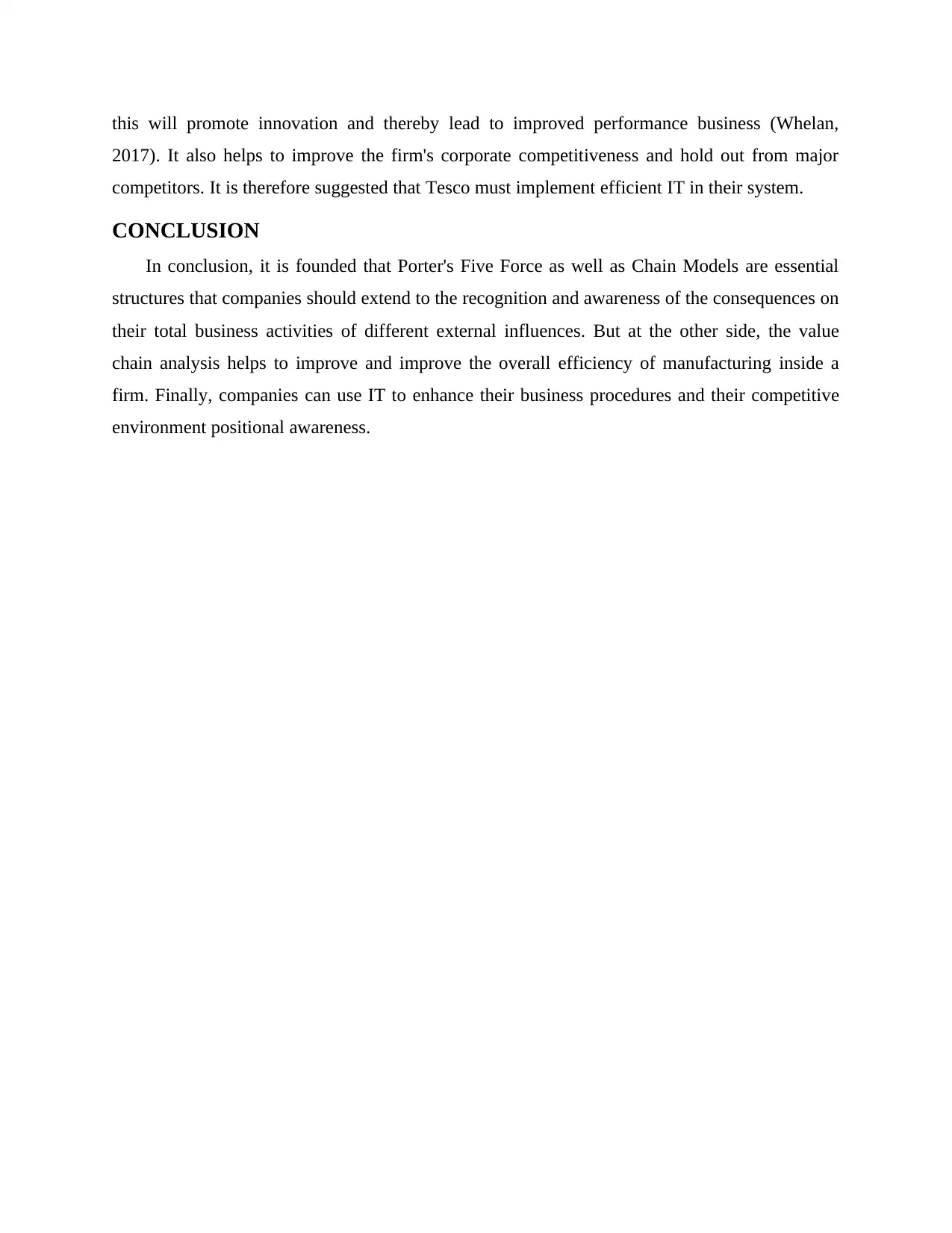
this will promote innovation and thereby lead to improved performance business (Whelan,
2017). It also helps to improve the firm's corporate competitiveness and hold out from major
competitors. It is therefore suggested that Tesco must implement efficient IT in their system.
CONCLUSION
In conclusion, it is founded that Porter's Five Force as well as Chain Models are essential
structures that companies should extend to the recognition and awareness of the consequences on
their total business activities of different external influences. But at the other side, the value
chain analysis helps to improve and improve the overall efficiency of manufacturing inside a
firm. Finally, companies can use IT to enhance their business procedures and their competitive
environment positional awareness.
2017). It also helps to improve the firm's corporate competitiveness and hold out from major
competitors. It is therefore suggested that Tesco must implement efficient IT in their system.
CONCLUSION
In conclusion, it is founded that Porter's Five Force as well as Chain Models are essential
structures that companies should extend to the recognition and awareness of the consequences on
their total business activities of different external influences. But at the other side, the value
chain analysis helps to improve and improve the overall efficiency of manufacturing inside a
firm. Finally, companies can use IT to enhance their business procedures and their competitive
environment positional awareness.
Paraphrase This Document
Need a fresh take? Get an instant paraphrase of this document with our AI Paraphraser
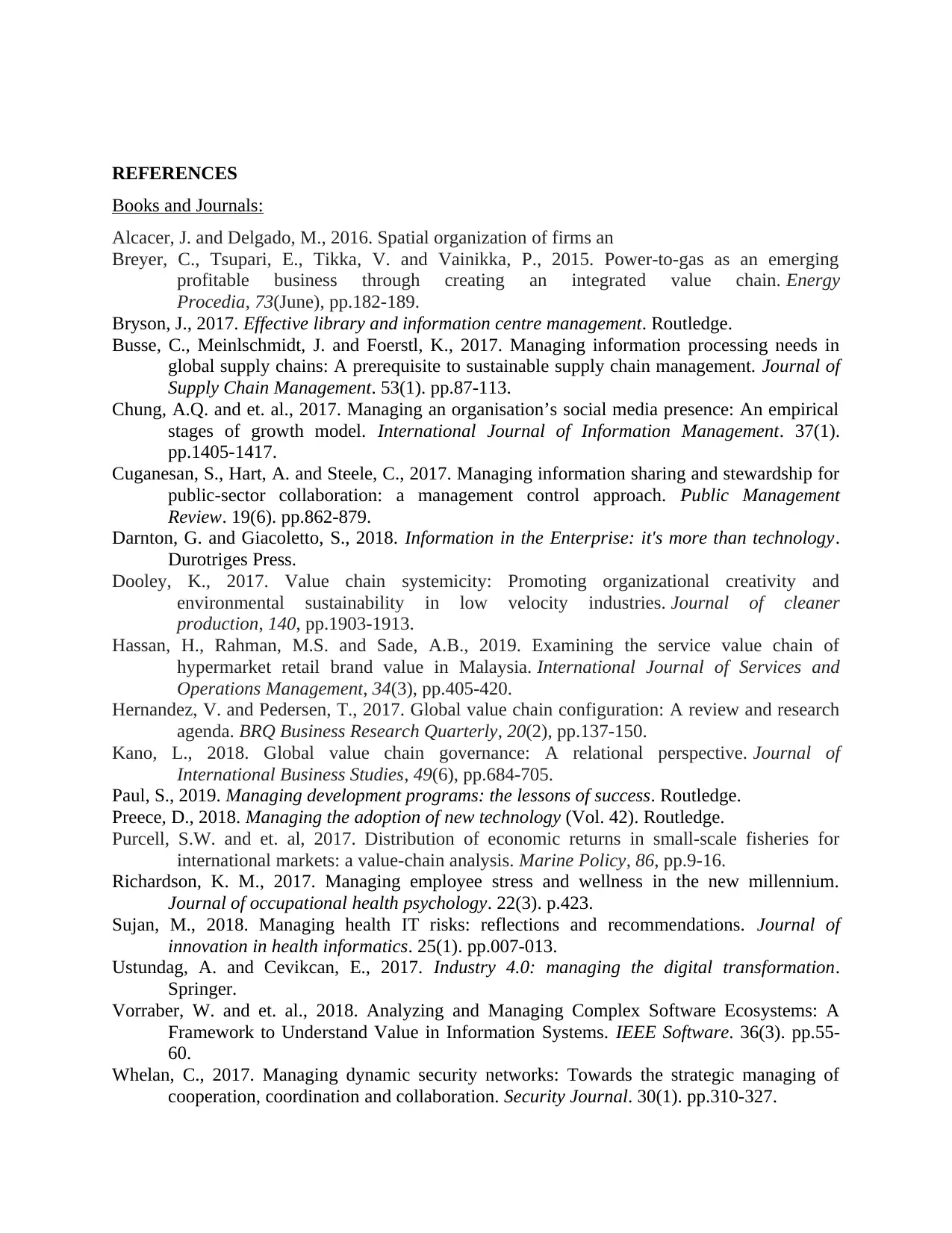
REFERENCES
Books and Journals:
Alcacer, J. and Delgado, M., 2016. Spatial organization of firms an
Breyer, C., Tsupari, E., Tikka, V. and Vainikka, P., 2015. Power-to-gas as an emerging
profitable business through creating an integrated value chain. Energy
Procedia, 73(June), pp.182-189.
Bryson, J., 2017. Effective library and information centre management. Routledge.
Busse, C., Meinlschmidt, J. and Foerstl, K., 2017. Managing information processing needs in
global supply chains: A prerequisite to sustainable supply chain management. Journal of
Supply Chain Management. 53(1). pp.87-113.
Chung, A.Q. and et. al., 2017. Managing an organisation’s social media presence: An empirical
stages of growth model. International Journal of Information Management. 37(1).
pp.1405-1417.
Cuganesan, S., Hart, A. and Steele, C., 2017. Managing information sharing and stewardship for
public-sector collaboration: a management control approach. Public Management
Review. 19(6). pp.862-879.
Darnton, G. and Giacoletto, S., 2018. Information in the Enterprise: it's more than technology.
Durotriges Press.
Dooley, K., 2017. Value chain systemicity: Promoting organizational creativity and
environmental sustainability in low velocity industries. Journal of cleaner
production, 140, pp.1903-1913.
Hassan, H., Rahman, M.S. and Sade, A.B., 2019. Examining the service value chain of
hypermarket retail brand value in Malaysia. International Journal of Services and
Operations Management, 34(3), pp.405-420.
Hernandez, V. and Pedersen, T., 2017. Global value chain configuration: A review and research
agenda. BRQ Business Research Quarterly, 20(2), pp.137-150.
Kano, L., 2018. Global value chain governance: A relational perspective. Journal of
International Business Studies, 49(6), pp.684-705.
Paul, S., 2019. Managing development programs: the lessons of success. Routledge.
Preece, D., 2018. Managing the adoption of new technology (Vol. 42). Routledge.
Purcell, S.W. and et. al, 2017. Distribution of economic returns in small-scale fisheries for
international markets: a value-chain analysis. Marine Policy, 86, pp.9-16.
Richardson, K. M., 2017. Managing employee stress and wellness in the new millennium.
Journal of occupational health psychology. 22(3). p.423.
Sujan, M., 2018. Managing health IT risks: reflections and recommendations. Journal of
innovation in health informatics. 25(1). pp.007-013.
Ustundag, A. and Cevikcan, E., 2017. Industry 4.0: managing the digital transformation.
Springer.
Vorraber, W. and et. al., 2018. Analyzing and Managing Complex Software Ecosystems: A
Framework to Understand Value in Information Systems. IEEE Software. 36(3). pp.55-
60.
Whelan, C., 2017. Managing dynamic security networks: Towards the strategic managing of
cooperation, coordination and collaboration. Security Journal. 30(1). pp.310-327.
Books and Journals:
Alcacer, J. and Delgado, M., 2016. Spatial organization of firms an
Breyer, C., Tsupari, E., Tikka, V. and Vainikka, P., 2015. Power-to-gas as an emerging
profitable business through creating an integrated value chain. Energy
Procedia, 73(June), pp.182-189.
Bryson, J., 2017. Effective library and information centre management. Routledge.
Busse, C., Meinlschmidt, J. and Foerstl, K., 2017. Managing information processing needs in
global supply chains: A prerequisite to sustainable supply chain management. Journal of
Supply Chain Management. 53(1). pp.87-113.
Chung, A.Q. and et. al., 2017. Managing an organisation’s social media presence: An empirical
stages of growth model. International Journal of Information Management. 37(1).
pp.1405-1417.
Cuganesan, S., Hart, A. and Steele, C., 2017. Managing information sharing and stewardship for
public-sector collaboration: a management control approach. Public Management
Review. 19(6). pp.862-879.
Darnton, G. and Giacoletto, S., 2018. Information in the Enterprise: it's more than technology.
Durotriges Press.
Dooley, K., 2017. Value chain systemicity: Promoting organizational creativity and
environmental sustainability in low velocity industries. Journal of cleaner
production, 140, pp.1903-1913.
Hassan, H., Rahman, M.S. and Sade, A.B., 2019. Examining the service value chain of
hypermarket retail brand value in Malaysia. International Journal of Services and
Operations Management, 34(3), pp.405-420.
Hernandez, V. and Pedersen, T., 2017. Global value chain configuration: A review and research
agenda. BRQ Business Research Quarterly, 20(2), pp.137-150.
Kano, L., 2018. Global value chain governance: A relational perspective. Journal of
International Business Studies, 49(6), pp.684-705.
Paul, S., 2019. Managing development programs: the lessons of success. Routledge.
Preece, D., 2018. Managing the adoption of new technology (Vol. 42). Routledge.
Purcell, S.W. and et. al, 2017. Distribution of economic returns in small-scale fisheries for
international markets: a value-chain analysis. Marine Policy, 86, pp.9-16.
Richardson, K. M., 2017. Managing employee stress and wellness in the new millennium.
Journal of occupational health psychology. 22(3). p.423.
Sujan, M., 2018. Managing health IT risks: reflections and recommendations. Journal of
innovation in health informatics. 25(1). pp.007-013.
Ustundag, A. and Cevikcan, E., 2017. Industry 4.0: managing the digital transformation.
Springer.
Vorraber, W. and et. al., 2018. Analyzing and Managing Complex Software Ecosystems: A
Framework to Understand Value in Information Systems. IEEE Software. 36(3). pp.55-
60.
Whelan, C., 2017. Managing dynamic security networks: Towards the strategic managing of
cooperation, coordination and collaboration. Security Journal. 30(1). pp.310-327.

Woodsworth, A. and Williams II, J. F., 2018. Managing the economics of owning, leasing and
contracting out information services. Routledge.
Online
About Tesco. 2020. [Online] Available Through:
<https://www.tescoplc.com/about/>.
About Goods and Services of Tesco. 2020. [Online] Available Through:
< https://corporatewatch.org/tesco-company-profile/ >.
contracting out information services. Routledge.
Online
About Tesco. 2020. [Online] Available Through:
<https://www.tescoplc.com/about/>.
About Goods and Services of Tesco. 2020. [Online] Available Through:
< https://corporatewatch.org/tesco-company-profile/ >.
⊘ This is a preview!⊘
Do you want full access?
Subscribe today to unlock all pages.

Trusted by 1+ million students worldwide
1 out of 12
Related Documents
Your All-in-One AI-Powered Toolkit for Academic Success.
+13062052269
info@desklib.com
Available 24*7 on WhatsApp / Email
![[object Object]](/_next/static/media/star-bottom.7253800d.svg)
Unlock your academic potential
© 2024 | Zucol Services PVT LTD | All rights reserved.





